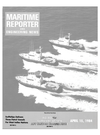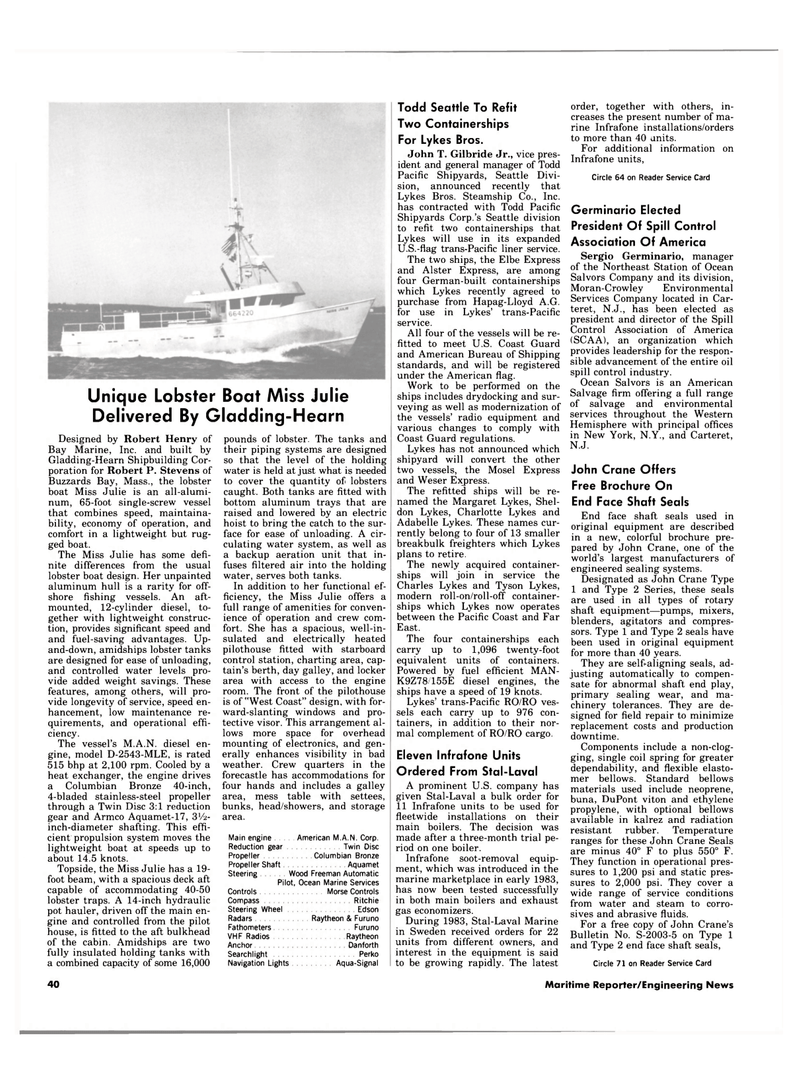
Page 38: of Maritime Reporter Magazine (April 15, 1984)
Read this page in Pdf, Flash or Html5 edition of April 15, 1984 Maritime Reporter Magazine
Unique Lobster Boat Miss Julie
Delivered By Gladding-Hearn
Designed by Robert Henry of
Bay Marine, Inc. and built by
Gladding-Hearn Shipbuilding Cor- poration for Robert P. Stevens of
Buzzards Bay, Mass., the lobster boat Miss Julie is an all-alumi- num, 65-foot single-screw vessel that combines speed, maintaina- bility, economy of operation, and comfort in a lightweight but rug- ged boat.
The Miss Julie has some defi- nite differences from the usual lobster boat design. Her unpainted aluminum hull is a rarity for off- shore fishing vessels. An aft- mounted, 12-cylinder diesel, to- gether with lightweight construc- tion, provides significant speed and and fuel-saving advantages. Up- and-down, amidships lobster tanks are designed for ease of unloading, and controlled water levels pro- vide added weight savings. These features, among others, will pro- vide longevity of service, speed en- hancement, low maintenance re- quirements, and operational effi- ciency.
The vessel's M.A.N, diesel en- gine, model D-2543-MLE, is rated 515 bhp at 2,100 rpm. Cooled by a heat exchanger, the engine drives a Columbian Bronze 40-inch, 4-bladed stainless-steel propeller through a Twin Disc 3:1 reduction gear and Armco Aquamet-17, 3'/2- inch-diameter shafting. This effi- cient propulsion system moves the lightweight boat at speeds up to about 14.5 knots.
Topside, the Miss Julie has a 19- foot beam, with a spacious deck aft capable of accommodating 40-50 lobster traps. A 14-inch hydraulic pot hauler, driven off the main en- gine and controlled from the pilot house, is fitted to the aft bulkhead of the cabin. Amidships are two fully insulated holding tanks with a combined capacity of some 16,000 pounds of lobster. The tanks and their piping systems are designed so that the level of the holding water is held at just what is needed to cover the quantity of lobsters caught. Both tanks are fitted with bottom aluminum trays that are raised and lowered by an electric hoist to bring the catch to the sur- face for ease of unloading. A cir- culating water system, as well as a backup aeration unit that in- fuses filtered air into the holding water, serves both tanks.
In addition to her functional ef- ficiency, the Miss Julie offers a full range of amenities for conven- ience of operation and crew com- fort. She has a spacious, well-in- sulated and electrically heated pilothouse fitted with starboard control station, charting area, cap- tain's berth, day galley, and locker area with access to the engine room. The front of the pilothouse is of "West Coast" design, with for- ward-slanting windows and pro- tective visor. This arrangement al- lows more space for overhead mounting of electronics, and gen- erally enhances visibility in bad weather. Crew quarters in the forecastle has accommodations for four hands and includes a galley area, mess table with settees, bunks, head/showers, and storage area.
Main engine American M.A.N. Corp.
Reduction gear Twin Disc
Propeller Columbian Bronze
Propeller Shaft Aquamet
Steering Wood Freeman Automatic
Pilot, Ocean Marine Services
Controls Morse Controls
Compass Ritchie
Steering Wheel Edson
Radars Raytheon & Furuno
Fathometers Furun
VHF Radios Raytheon
Anchor Danforth
Searchlight Perko
Navigation Lights Aqua-Signal
Todd Seattle To Refit
Two Containerships
For Lykes Bros.
John T. Gilbride Jr., vice pres- ident and general manager of Todd
Pacific Shipyards, Seattle Divi- sion, announced recently that
Lykes Bros. Steamship Co., Inc. has contracted with Todd Pacific
Shipyards Corp.'s Seattle division to refit two containerships that
Lykes will use in its expanded
U.S.-flag trans-Pacific liner service.
The two ships, the Elbe Express and Alster Express, are among four German-built containerships which Lykes recently agreed to purchase from Hapag-Lloyd A.G. for use in Lykes' trans-Pacific service.
All four of the vessels will be re- fitted to meet U.S. Coast Guard and American Bureau of Shipping standards, and will be registered under the American flag.
Work to be performed on the ships includes drydocking and sur- veying as well as modernization of the vessels' radio equipment and various changes to comply with
Coast Guard regulations.
Lykes has not announced which shipyard will convert the other two vessels, the Mosel Express and Weser Express.
The refitted ships will be re- named the Margaret Lykes, Shel- don Lykes, Charlotte Lykes and
Adabelle Lykes. These names cur- rently belong to four of 13 smaller breakbulk freighters which Lykes plans to retire.
The newly acquired container- ships will join in service the
Charles Lykes and Tyson Lykes, modern roll-on/roll-off container- ships which Lykes now operates between the Pacific Coast and Far
East.
The four containerships each carry up to 1,096 twenty-foot equivalent units of containers.
Powered by fuel efficient MAN-
K9Z78/155E diesel engines, the ships have a speed of 19 knots.
Lykes' trans-Pacific RO/RO ves- sels each carry up to 976 con- tainers, in addition to their nor- mal complement of RO/RO cargo.
Eleven Infrafone Units
Ordered From Stal-Laval
A prominent U.S. company has given Stal-Laval a bulk order for 11 Infrafone units to be used for fleetwide installations on their main boilers. The decision was made after a three-month trial pe- riod on one boiler.
Infrafone soot-removal equip- ment, which was introduced in the marine marketplace in early 1983, has now been tested successfully in both main boilers and exhaust gas economizers.
During 1983, Stal-Laval Marine in Sweden received orders for 22 units from different owners, and interest in the equipment is said to be growing rapidly. The latest order, together with others, in- creases the present number of ma- rine Infrafone installations/orders to more than 40 units.
For additional information on
Infrafone units,
Circle 64 on Reader Service Card
Germinario Elected
President Of Spill Control
Association Of America
Sergio Germinario, manager of the Northeast Station of Ocean
Salvors Company and its division,
Moran-Crowley Environmental
Services Company located in Car- teret, N.J., has been elected as president and director of the Spill
Control Association of America (SCAA), an organization which provides leadership for the respon- sible advancement of the entire oil spill control industry.
Ocean Salvors is an American
Salvage firm offering a full range of salvage and environmental services throughout the Western
Hemisphere with principal offices in New York, N.Y., and Carteret,
N.J.
John Crane Offers
Free Brochure On
End Face Shaft Seals
End face shaft seals used in original equipment are described in a new, colorful brochure pre- pared by John Crane, one of the world's largest manufacturers of engineered sealing systems.
Designated as John Crane Type 1 and Type 2 Series, these seals are used in all types of rotary shaft equipment—pumps, mixers, blenders, agitators and compres- sors. Type 1 and Type 2 seals have been used in original equipment for more than 40 years.
They are self-aligning seals, ad- justing automatically to compen- sate for abnormal shaft end play, primary sealing wear, and ma- chinery tolerances. They are de- signed for field repair to minimize replacement costs and production downtime.
Components include a non-clog- ging, single coil spring for greater dependability, and flexible elasto- mer bellows. Standard bellows materials used include neoprene, buna, DuPont viton and ethylene propylene, with optional bellows available in kalrez and radiation resistant rubber. Temperature ranges for these John Crane Seals are minus 40° F to plus 550° F.
They function in operational pres- sures to 1,200 psi and static pres- sures to 2,000 psi. They cover a wide range of service conditions from water and steam to corro- sives and abrasive fluids.
For a free copy of John Crane's
Bulletin No. S-2003-5 on Type 1 and Type 2 end face shaft seals,
Circle 71 on Reader Service Card 40 Maritime Reporter/Engineering News

 37
37

 39
39
